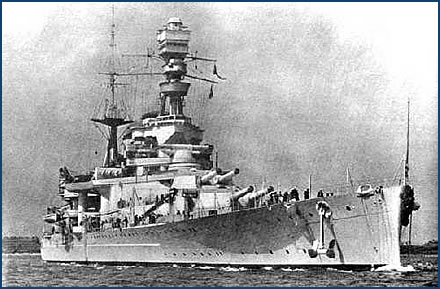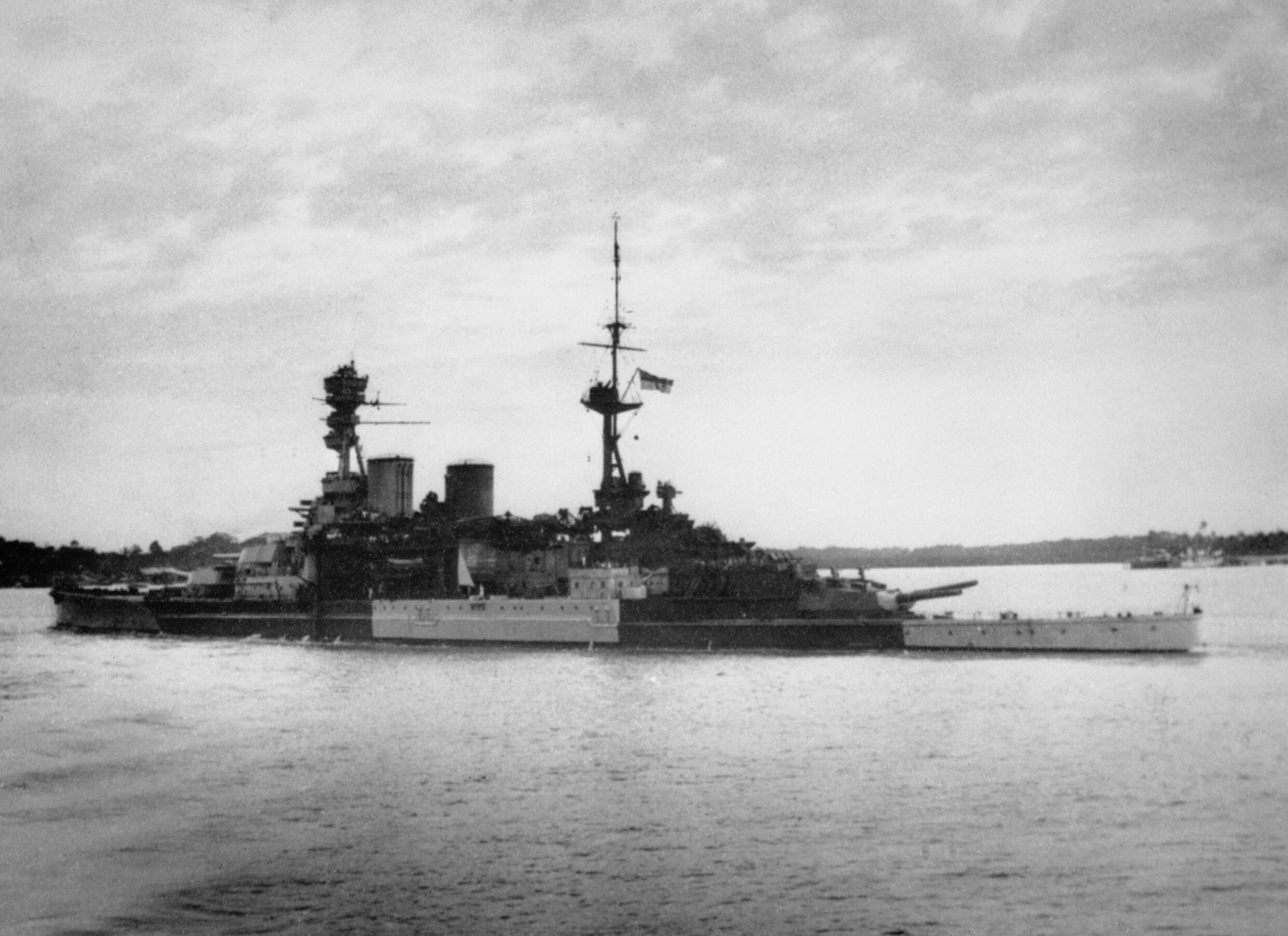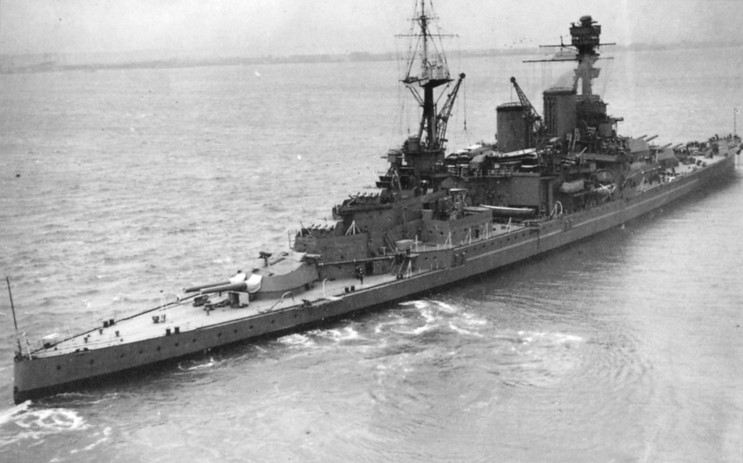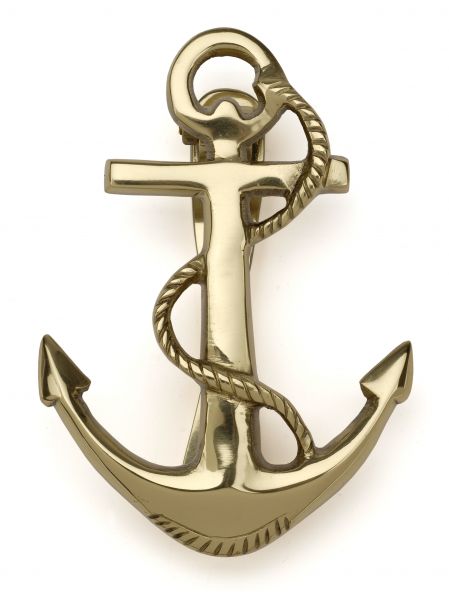


HMS Repulse was a Renown-class battlecruiser, the second to last battlecruiser built by John Brown and Company, Clydebank, Scotland, for the Royal Navy. She was originally intended to be a unit of the R class battleships, but was ordered to a modified design. She was launched in 1916, too late to take part in the Battle of Jutland, but also too early to incorporate the lessons of that battle. Still in time to take part in the First World War, in September 1916, she joined the Grand Fleet as flagship of the 1st Battlecruiser Squadron.

Considered a high-maintenance ship, she was given the unflattering nickname HMS Repair. Her sister, Renown, was nicknamed HMS Refit. Repulse's first re-build took place from 1918 to 1920. The major element of refit was the replacement of her 6 inch (152 mm) armour belt with 9 inches (229 mm) and a further 6 inch (152 mm) section above it protecting what had previously been unarmoured. Together with improved anti-torpedo bulges, this meant an additional 4,300 tons of armour. Her torpedo tubes were moved from underwater to on the deck.
In 1924-1925, the mixture of low angle 4 inch (102 mm) and high angle 3 inch (76 mm) guns were changed to 4 inch (102 mm) high angle guns. Also included were improvements to the anti-aircraft armament, and facilities for a spotter aircraft. From 1929 to 1931, Repulse was commanded by Captain Gerald Charles Dickens.
The last major refit was 1933-1936, when she received more armour, more anti-aircraft guns (2 pdr pom-poms (40 mm) and 0.5 inch (12.7 mm) Vickers machine guns) and an aircraft catapult with two hangars. Initially, the aircraft were Blackburn Shark floatplanes (replaced by 1939 with Fairey Swordfish and again in 1941 by the Supermarine Walrus). After the refit, she went on the Mediterranean, participating in Spanish Neutrality Patrol duties. In July 1938, she was present at Haifa, during the Palestinian uprisings that summer. John Henry Godfrey was her Captain from 1936 until he was appointed Director of Naval Intelligence in 1939.
Second World War
After the outbreak of the Second World War in 1939, Repulse operated in various hunting groups that were formed to hunt down German commerce raiders. However, she did not engage any. In December, she performed escort duty for troop carriers between Canada and Britain. The start of the Allied campaign in Norway saw Repulse covering minelaying by British forces. In July, 1940, when HMS Glowworm was lost attacking Admiral Hipper, Repulse took part in the search, but failed to make contact. Towards the end of the campaign, during the evacuation of British troops, due to concern that an invasion of Iceland was in process, Repulse was detached from protecting Norway convoys to search for the invasion force. In fact, no invasion was under way. Subsequently Repulse returned to convoy protection through early 1941.
In January 1941, Repulse participated in the hunt for the German battlecruisers Scharnhorst and Gneisenau. In May, she took part in the chase of Bismarck. Originally scheduled to escort convoy WS-8B to the Middle East around Africa, Repulse operated as part of the Home Fleet, but was detached from the main body prior to the last engagement due to fears of a repeat of the loss of HMS Hood and to lack of fuel. In August, she was transferred to Cape Town, South Africa, and in October, she was transferred to India, arriving on 28 October.

At the end of 1941, as the threat of war with Japan loomed ever larger, Repulse was detached to the Far East as a deterrent to Japanese aggression. This force, long envisioned in Admiralty strategic planning as a large battle fleet designed to act as a Fleet-in-being and as a counter to Japanese intentions, eventually was dispatched to Singapore as an under-strength squadron. Its inability to act as a deterrent would soon be exposed.
Initially designated as Force G, this squadron was sent without the planned for aircraft carrier to Singapore. Shortly after the outbreak of war in the Pacific on 8 December 1941, Repulse left Singapore in company with the other major element of the Eastern Fleet, the fast battleship HMS Prince of Wales, and four destroyers, to try and intercept Japanese invasion convoys heading towards Malaya. The commander of the fleet (known as Force Z), Admiral Sir Tom Philips, flying his flag in Prince of Wales, knew that British forces could not guarantee to provide air cover for his forces, but elected to proceed anyway because he thought that Japanese forces could not operate so far from land, and he also thought that his ships were relatively immune from fatal damage via air attack, since up to that point, no capital ship at sea had ever been sunk by air attack. The largest unit which had been sunk solely by aircraft up to this time was a heavy cruiser.
However, on 10 December 1941, after failing to find any Japanese invasion forces, and turning south, the Force spotted Japanese aircraft. The fleet was attacked by 86 Japanese aircraft from the 22nd Air Flotilla based in Saigon, which attacked both Prince of Wales and Repulse. In the ensuing attacks, Repulse was ably handled by her Captain, Bill Tennant, who managed to comb several torpedo attacks. However, Repulse's luck was not to hold out and she was caught by a skilfully synchronised Japanese pincer attack and hit by four or even five torpedoes in rapid succession.
Repulse was fatally hit and soon developed a severe list to port over a period of about six minutes. It was clear that she was sinking, and sinking fast, resulting in Tennant ordering abandon ship. Repulse finally rolled over and sank at 12:23. The story of the sinking of Repulse was told in the 1942 book, Suez to Singapore, written by CBS Radio war correspondent Cecil Brown.
Although an older ship than Prince of Wales, Repulse survived a bomb hit and managed to dodge 19 torpedoes before being sunk in 20 minutes after receiving 5 torpedo hits. However unlike Prince of Wales, when Repulse's end came it was far quicker and resulted in a greater loss of life.
Prince of Wales (left, front) and Repulse (left, behind) under Japanese air attack on 10 December 1941. A destroyer, either Electra or Express, is manoeuvring in the foreground.

The destroyers HMS Electra and HMAS Vampire moved in to rescue survivors of Repulse, while Express rescued survivors of Prince of Wales. Even after they were rescued, some survivors of Repulse manned Action Stations on Electra, to free her sailors to rescue more survivors. In particular, Repulse gunners manned the 'X' and 'Y' 4.7 inch mounts, and the ship's dentist of Repulse assisted the Electra's medical teams with the wounded. In total, 1,285 survivors of Repulse were rescued, of which Electra saved 571; 327 died. Electra and the other destroyers then returned to Singapore to drop off the survivors.
The sinking of Repulse and Prince of Wales by aerial attack demonstrated that capital ships were vulnerable unless properly protected by aircraft from shore or aircraft carriers. The wreck site was designated as a 'Protected Place' in 2001 under the Protection of Military Remains Act 1986, just prior to the 60th anniversary of her sinking.




No comments:
Post a Comment